Where are the Caddis?
Resolving a Fly Fishing Mystery...
In college, the professor I had for my Ichthyology and Fisheries classes had a favorite saying when we asked what he thought was a dumb question. Branley Branson would hit you with “It should be intuitively obvious to the trained observer”. Perhaps I have finally become a trained observer.
Historically we have waited for mid-February to come to the Missouri Ozarks. The days, and perhaps more important, the nights are starting to warm. That means it is time to start fishing the little gray bodied cadis hatch! The springs that feed Ozark streams such as the Current River, come bubbling to the surface with a relatively constant temperature all year. Once the spring water is exposed to the surface it starts to warm or cool depending on the ambient temperature. In winter the temperatures fall, especially at night when there is no sun to warm the stream. This is where the “warn night” part comes in. In biology there is what is known as the Q10 rule. It says that for cold-blooded aquatic animals, activity doubles if the temperature increases by 10°C. That means a decrease of just a few degrees will significantly reduce activity. But on the other hand, a small increase in temperature will trigger activity. I had been following the weather closely. About the first week of March things were looking good for warm days and warm overnight temperatures. On the 5th I was on the Current at my favorite location where a rocky run transitioned into a pool. I was there but where were the caddis? Oh, I caught the odd brown from time to time but I never really saw the hatch. The few fish I got all came from one of the low bluffs or areas with what we call “chunk” rock that has fallen off a bluff. I laid the blame for the few fish on the windy conditions. It seemed like the few fish I caught were right after a gust of wind. I assumed that the wind had blown some caddis out of the trees and onto the water. I also noticed that this year there didn’t appear to nearly as many caddis in the trees along the banks.
 One week later I was back. Conditions were perfect – warm day, warm night, warm day and no wind. Again nothing was happening at my go-to locations. Then I made an observation. Caddis were hatching and fish were rising for them, it was just not in the typical locations. All the action was occurring immediately below what we call “sweepers” - trees that hang out into or across the water with some branches below the water. But why below the sweepers and not in the typical transitions from the rocky runs into the pools as it had been for the past several years? Find a sweeper and the little gray caddis did the trick!
One week later I was back. Conditions were perfect – warm day, warm night, warm day and no wind. Again nothing was happening at my go-to locations. Then I made an observation. Caddis were hatching and fish were rising for them, it was just not in the typical locations. All the action was occurring immediately below what we call “sweepers” - trees that hang out into or across the water with some branches below the water. But why below the sweepers and not in the typical transitions from the rocky runs into the pools as it had been for the past several years? Find a sweeper and the little gray caddis did the trick!
 Last year, right around St. Patrick Day, we had more floods with much higher levels than we had in the past several years. We were thrilled to see water levels back closer to long term average levels. But, some of these runoff events resulted in very significant flood levels. In one case the gauge that measures flow at the headwaters area of the Current River went up nearly 7 feet overnight! Less than a month latter the level rose again, this time to six feet.
Last year, right around St. Patrick Day, we had more floods with much higher levels than we had in the past several years. We were thrilled to see water levels back closer to long term average levels. But, some of these runoff events resulted in very significant flood levels. In one case the gauge that measures flow at the headwaters area of the Current River went up nearly 7 feet overnight! Less than a month latter the level rose again, this time to six feet.
These runoff events had some major impacts on the river. The first time back on the river, we had to relearn conditions. A lot of gravel had moved. The riffles were still there but the substrate had shifted and some of the pools were not as deep. While there was some limited effects on the fisheries, research has shown that the majority of the fish populations are able to cope with the flooding by moving into protected areas. For the caddis larva living on the gravel in the riffles, there was no escape, they were simply washed away or ground up by the tumbling rocks.
But why were there caddis coming off behind the sweepers? Driving home that night I had a moment that would have made Branley proud. The caddis mystery did become intuitively obvious. I put 2 and 2 together and I think I got 4 and not 3.987. Here is the math:
- The storm runoff removed most of the larva living on the rocks.
- Bank erosion and sloughing caused trees to fall into the river providing the “sweepers.”
- The “sweepers” were colonized and provided a stable habitat for the caddis larva, especially during the second rise of 6 feet.
Adding the factors up, I didn’t get 4 after all. I got something close to 17.75. I don’t care if my math was wrong if I can get that kind of an answer!.
 The real math lesson of these trips was something that we preach in our seminars, classes and while out on the stream with clients. Don’t assume that the same strategy that you used last week, last year, or even yesterday on a different river will work all the time. Be observant of what the conditions and situations are while you are there. Make Branley proud and catch more fish by having conditions be “Intuitively obvious to the trained observer”!
The real math lesson of these trips was something that we preach in our seminars, classes and while out on the stream with clients. Don’t assume that the same strategy that you used last week, last year, or even yesterday on a different river will work all the time. Be observant of what the conditions and situations are while you are there. Make Branley proud and catch more fish by having conditions be “Intuitively obvious to the trained observer”!